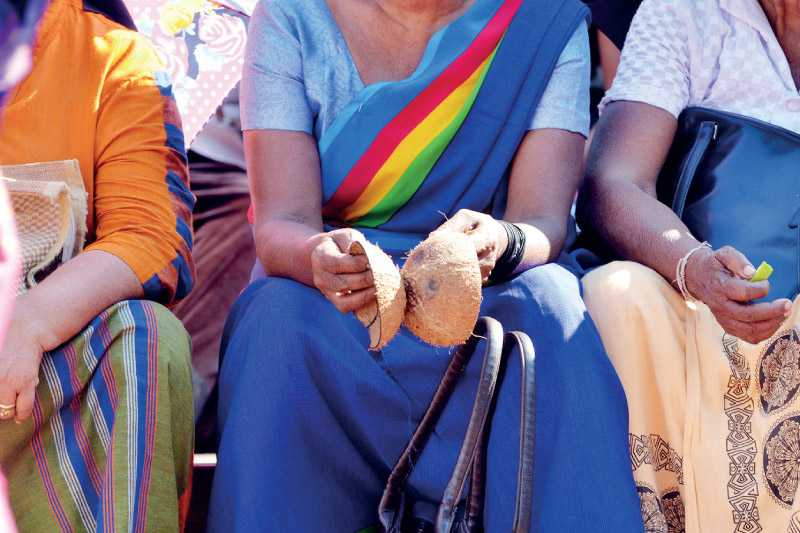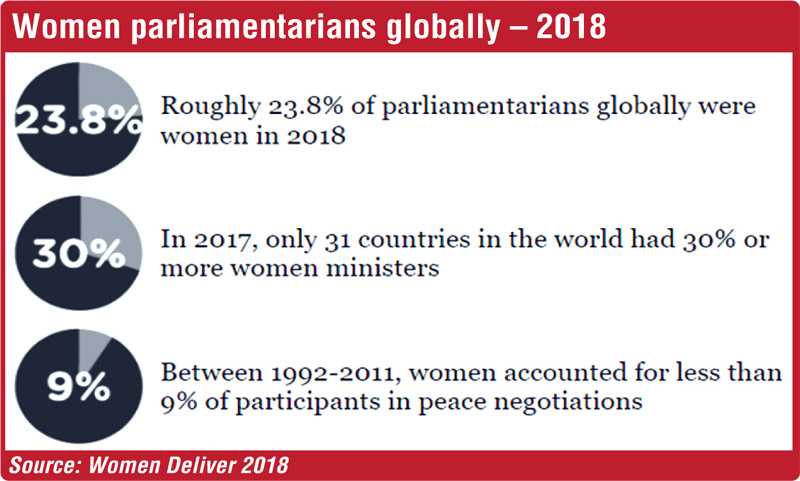Friday Jun 28, 2024
Friday Jun 28, 2024
Thursday, 18 March 2021 00:02 - - {{hitsCtrl.values.hits}}

Women in Sri Lanka comprise 56% of voters, but only 5% of legislators. Sixty years since Sirimavo’s election, women’s political representation in the Sri Lankan Parliament remains abysmally low – Pic by Shehan Gunasekara
 The last 50 years have seen significant advances in gender equality in many domains around the world. Women still lag behind men in different—often linked and reinforcing—dimensions, such as their ability to access resources, employment, and entrepreneurship opportunities, as well as powerful positions in the political sphere and corporate boards.
The last 50 years have seen significant advances in gender equality in many domains around the world. Women still lag behind men in different—often linked and reinforcing—dimensions, such as their ability to access resources, employment, and entrepreneurship opportunities, as well as powerful positions in the political sphere and corporate boards.
The Government has launched several programs to promote women. Through these schemes, efforts have been made to ensure that women are equal to men in the economic and political spheres. However due to many challenges they have gone unfulfilled. So, the fact that women are still not equal to men in industry and politics has brought many economic setbacks.
Gender inequality in Sri Lanka still exists in many key sectors. For example, the gender gap in education has narrowed significantly and in many developed and developing countries the tertiary level (at the disadvantage of males) has reversed and the number of maternal deaths worldwide has dropped dramatically in recent decades.
However, improvements have not been fully reflected in the comparative gains in human capital employment opportunities or the increased political voice for women. Although there has been tremendous improvement in recent decades, gender gaps in economic opportunities and political participation persist in many countries, with some gender differences widening in developing countries.
Women’s access to property and productive resources remain weak and often dependent on males. Moreover, many jobs continue to be segregated by gender, with women more likely to be employed in low-paying jobs, as unpaid family workers, or in the informal sector—contributing to the gender gap in earnings. So, a country can achieve real development only when it promotes gender equality in all development activities.
Sri Lanka has made significant progress in this regard in Asia. It has been working for a long time with many government and private sector representatives. However, it still has a number of goals ahead to achieve.
Women’s politics empowerment
While the participation of women in politics is increasing in other countries, it is still slow in Sri Lanka. In 2018, women only occupied 23% of the parliamentary seats in the world, while men had 77%, implying that politics is still a heavily male-dominated arena (Women Deliver 2018). Today, however, we see the emergence of new discourses of women’s under-representation followed by many old as well as new strategies to change this under-representation.
Women continue to be largely underrepresented in political office, corporate boards, and other high-level leadership positions (World Bank 2011). This segregation extends to public office, with women more likely to be assigned to cabinet positions that are less influential (Krook and O’Brien 2012).
Women in Sri Lanka comprise 56% of voters, but only 5% of legislators. Sixty years since Sirimavo’s election, women’s political representation in the Sri Lankan Parliament remains abysmally low. In 2020, only 5.3% — 12 out of 225 legislators — in the Sri Lankan Parliament are women. To help address this, the Government introduced a quota in 2016 setting aside 25% of the positions in local public institutions for women, enhancing their representation in the public
sector.
Many countries have been at the forefront of equal representation of women in politics in the world. Ruwanda, Cuba and Bolivia Despite being the majority of the electorate at 52% of the total population and 56 percent of the registered voters, female voices remain absent from formal politics. Sri Lanka ranks 182nd out of 193 countries on the Inter-Parliamentary Union (IPU), a global database that ranks countries by the percentage share of women in their national parliament.
Women and economic development
Gender equality is an important development objective by itself and is closely related to economic development (World Bank 2011; Duflo 2012; Jayachandran 2015). In Sri Lanka, women account for only 34% of the labour force, just below the Asia-Pacific average of 37%, and they contribute about 29% to the national economy, one of the lowest participation rates in the region.
The importance of achieving gender equality within and outside the household has been reaffirmed in the recently adopted United Nations Sustainable Development Goals (SDGs). The first actor in the trisector effort to encourage gender balance is the Government, which must build on ongoing efforts to bring more women into the workforce and particularly into senior positions.
In Sri Lanka, women’s labour force participation rate is at a mere 34% in comparison to 72.4% for men. Similarly, the youth unemployment rate for women is at 36.3% compared with 21.1% for men. Women’s labour force participation in the country is often compounded by many factors such as the lack of affordable and quality childcare services, lack of support in sharing household work and some workplace cultures that are not supportive of women employees.
Further, as many women are engaged in informal employment, crises such as COVID-19 have disproportionately affected female-headed households which make up over a quarter of Sri Lankan homes. Many female heads of households therefore lack access to social protections and are more likely to carry a triple burden in supporting their family whilst engaging in unpaid care work and domestic work.
Some important steps to improve inequality
Political empowerment
Bringing women equally to men in politics reduces the gender gap in the country and raises their voice in matters of policy and planning. Efforts to improve female representation in politics have often focused on quotas and reserved shares. Quotas can definitely help to ensure the number of allocations for women representatives. Paving the way for more women in the political, business, and civic arena is an investment in more just, equitable, and peaceful societies.
So, to increase female representation in politics, female children should be taught about rights of them by parents and schools. Also, female students should be given more changes to lead students’ unions, associations. In addition, the laws should be introducing to make all the political parties to appoint a mandatory female quota to their politburos. Also, to make the mandatory 25% female quota more efficient, the number of women who contest for elections should be increased.
Women are more qualified than their male counterparts, but the prevalent patriarchal norms and institutional structures hinder them from achieving their fullest potential. This is why institutional reforms become key in electing more women to the parliament until we reach a gender-balanced parliament.
So, girls and women have a right to engage in civil society, vote in elections, be elected to government office, serve on boards, and make their voices heard in any process that will ultimately affect them, their families, and their communities. Investing in girls’ and women’s right to political participation is a necessary step to achieving national gender equality and democratic governance.
Economic empowerment
Women’s economic empowerment is central to realising women’s rights and gender equality.
Women’s economic empowerment includes women’s ability to participate equally in existing markets; their access to and control over productive resources, access to decent work, control over their own time, lives and bodies; and increased voice, agency and meaningful participation in economic decision-making at all levels from the household to international institutions.
Empowering women in the economy and closing gender gaps in the world of work are key to achieving the 2030 Agenda for Sustainable Development.
Particularly some corporations in Sri Lanka are working to improve equity further. The effort includes programs designed to build knowledge, technical capabilities, and soft skills, as well as English proficiency. And also, another significant step is to improve women’s access to digital technology.
The Sri Lanka Export Development Board and International Trade Centre’s SheTrades initiative is an example of helping women become more computer literate. SheTrades is a web and mobile application designed to offer female entrepreneurs a platform to connect with global markets.
Reskilling and upskilling strategies
Increasing women’s and girls’ educational attainment contributes to women’s economic empowerment and more inclusive economic growth. Education, upskilling and re-skilling over the life course – specially to keep pace with rapid technological and digital transformations affecting jobs—are critical for women’s and girl’s health and wellbeing, as well as their income-generation opportunities and participation in the formal labour market.
Sri Lanka is one of three countries in Asia, along with the Philippines and Indonesia, where women migrants constitute between 60 and 70% of legal migrants; these female migrants are mainly employed overseas as domestic workers where more than 90% of female migrant workers from Sri Lanka are low skilled. So, the following recommendations can be considerable,
Conduct awareness programs for more females to study nursing, home economics, hotel reception, food and beverage, airline ticketing, beautician courses, etc. will be an important activity. And also, organize awareness campaign on available job opportunities in industries and available skills training courses in state and private training institutions
Reduce low-skilled labour migration and increase skilled labour migration is one of another milestones. As well as produce a skilled labour force which has greater demand from labour markets. Improving the relevance and quality of training programs. The need for private sector involvement.
Expand industry-linked internships and school-based business incubator and exposure programs for female students at the secondary school level must be introduced. The higher education institutes can provide proper career counselling and job market information.
Workplace improvement
Reduce barriers to female participation in paid work, particularly lack of child care services and socio-physical constraints on women’s mobility.
Expansion of opportunities for females to access part-time work and maternity leave.
Expansion of opportunities for female to generate income in their homes by providing some combination of technical and vocational training, financial literacy and business development training, access to credit or other financial assistance, and links to markets.
Improved public transportation safety for women, and create partnerships with private employers to encourage firm-specific transportation for female workers

Footnotes